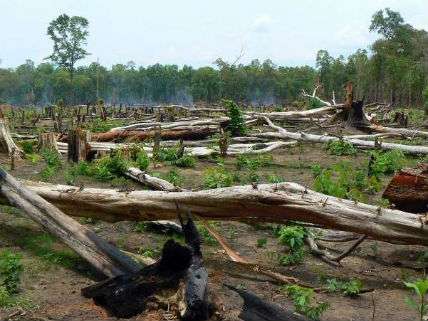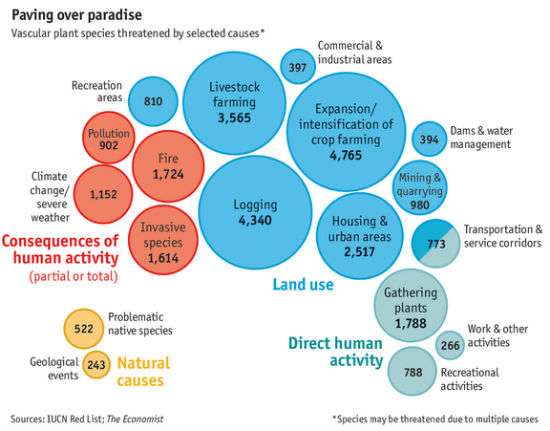One-Fifth of Earth's Plants Threatened with Extinction
Recent trends on population, farmland, deforestation, and urbanization are cause for optimism.

The highly respected Royal Botanic Gardens, Kew, has just issued The State of the World's Plants 2016 in which its researchers estimate that perhaps one-fifth of the world's 391,000 vascular plant species may be at risk of extinction. The chief reason plant species are threatened is human activity, specifically land use changes such as farming, raising livestock, logging, and land development. The Kew findings rely heavily on research published last year, "Green Plants in the Red," in PLoS One by a team of mostly British researchers associated with the Natural History Museum and Kew Gardens. According to the journal metrics that article received no media coverage, which may be why the results are being updated and republished in the splashy report.
To try to estimate how many plants are threatened with extinction, the researchers took a random sample consisting of some 7,000 plant species and then checked to see how they are faring using data from the International Union for the Conservation of Nature (IUCN). The IUCN constructs and maintains various databases called Red Lists aiming to monitor the conservation status of species populations.
The PLoS One study reported, "More than 20% of plant species assessed are threatened with extinction, and the habitat with the most threatened species is overwhelmingly tropical rain forest, where the greatest threat to plants is anthropogenic habitat conversion, for arable and livestock agriculture, and harvesting of natural resources." The study also calculated that "arable farming affects 60% of threatened species, while livestock farming affects 47%, logging affects 38%, targeted harvesting affects 25% and fires (natural or man-made) also affect 25% of threatened species."

In addition, the PLoS One study estimated that with 79% of threatened plant species are found in forests, followed by 19% of threatened species in shrubland, 13% in rocky outcrops, 10% in savanna and also 10% in grassland percentages do not sum to 100% as some species occur in more than one habitat). The fewest threatened species were found in deserts and wetlands, largely because those areas are least suited for agriculture.
So that's the bad news. But the good news is peak farmland and plantation forestry. As I report in my chapter on extinction in my book The End of Doom:
Considering that agriculture is the most expansive and intensive way in which people transform natural landscapes, the really good news is that the amount of land globally devoted to food production may be falling as population growth slows and agricultural productivity increases. "We believe that projecting conservative values for population, affluence, consumers, and technology shows humanity peaking in the use of farmland," conclude Jesse Ausubel, the director of the Program for the Human Environment at Rockefeller University, and his colleagues in their 2013 article "Peak Farmland and the Prospect for Land Sparing." They add, "Global arable land and permanent crops spanned 1,371 million hectares in 1961 and 1,533 million hectares in 2009, and we project a return to 1,385 million hectares in 2060." As a result of these trends, humanity will likely restore at least 146 million hectares, an area two and a half times that of France or the size of ten Iowas, and possibly much more land. "Another 50 years from now, the Green Revolution may be recalled not only for the global diffusion of high-yield cultivation practices for many crops, but as the herald of peak farmland and the restoration of vast acreages of Nature," write the researchers. "Now we are confident that we stand on the peak of cropland use, gazing at a wide expanse of land that will be spared for Nature."
Also in The End of Doom I note:
Resources for the Future analyst Roger Sedjo estimates that most of the world's wood products could be derived from tree plantations occupying about 7 percent of the world's currently forested area. Improving the productivity of tree plantations by means of biotechnology would shrink that area even further. Cultivating trees on plantations spares land for natural forests to grow, and the more productive the trees, the more the land that can be spared for nature.
A couple of months after my book came out, the Food and Agriculture Organization published its new Forest Resources Assessment and reported that that rate of deforestation had already fallen by half between 1990 and 2010. And what is more, the rate of deforestation was likely to continue decelerating.
And finally, most people are moving off of hard scrabble farms and into cities. From The End of Doom:
Demographers expect that 80 percent of people will live in urban areas by 2050 or so. Setting aside the demographic fact that people who live in cities have fewer children, what this trend means is that a lot fewer people will be living on the landscape in the future. Today, about half of the world's population of 7.2 billion people lives in rural areas. Assuming that world population grows to 9 billion by 2050 and that 80 percent do live in cities, that would mean that only 1.8 billion would be on the landscape, as compared to 3.6 billion today. If world population tops out at 8 billion, then only 1.6 billion people would live in the countryside—2 billion fewer people than live there now.
The new data on the vulnerability of plants to extinction from the Kew researchers is sobering, but there are lots of positive trends that suggest that the 21st century will be a century of environmental renewal, rather than one of ecological ruin.


Show Comments (40)